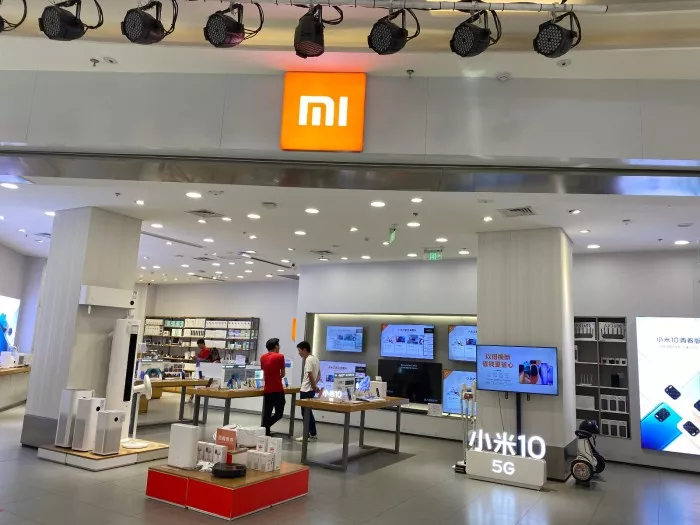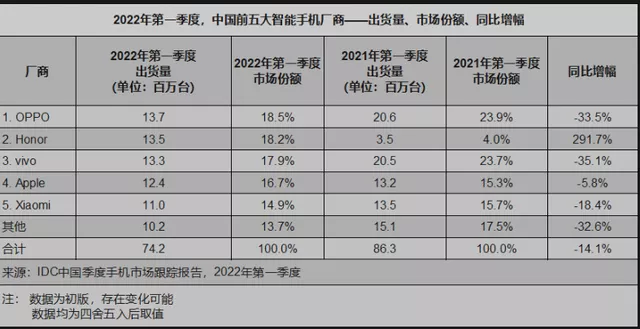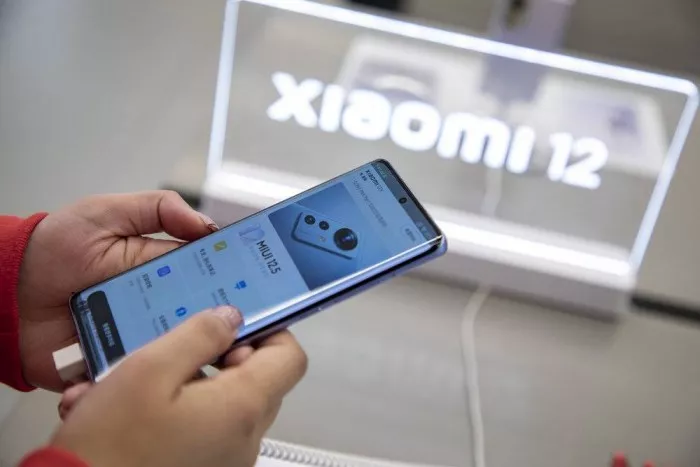At the end of 2020, the economist once put forward a word "Mi time", which means that after Huawei is sanctioned, Xiaomi will carry the banner of domestic smart phones, and the industry is about to usher in Xiaomi moment. However, judging from Xiaomi's recent performance, such a vision is still difficult to achieve in the short term.

Author | marudushan
On the evening of May 19, Xiaomi group released the financial report for the first quarter of 2022. During the reporting period, Xiaomi achieved a revenue of 73.352 billion yuan, a year-on-year decrease of 4.6%; The loss during the period was 531 million yuan and the profit in the same period last year was 7.789 billion yuan; The adjusted net profit was 2.859 billion yuan, down 52.9% year-on-year.
The revenue scale of about 73.4 billion yuan, which is the first time that Xiaomi has recorded a year-on-year decline in revenue in a single quarter since its listing on the Hong Kong Stock Exchange in July 2018.
Objectively speaking, under the influence of global persistent core shortage, repeated epidemics and global macroeconomic fluctuations, the reduction of revenue is not surprising, and even in line with the low expectations given by the market, but the halving of net profit can no longer be explained by environmental factors, and the high-end goal of its mobile phone business has even played a counterproductive role in this process.
According to the first quarterly report, during the period of Xiaomi, the average selling price of global intelligence (ASP) reached 1189 yuan, up 14.1% year-on-year. However, to some extent, this may be due to Xiaomi's previous rounds of price reduction and promotion of flagship models. The strategy of "volume for price" seems to run counter to Xiaomi's high-end strategy.
Who is grabbing Xiaomi's profits
2.859 billion, the lowest level of Xiaomi's single quarter profit since the second quarter of 2020, when the global epidemic was still in the most severe stage.
From the perspective of revenue structure, the mobile phone business is still the absolute core of Xiaomi. In the first quarter, the revenue reached 45.8 billion, accounting for 62% of the revenue, but this cornerstone business is facing a serious impact. The first quarter report shows that the shipment of Xiaomi smart phones reached 38.5 million, a year-on-year decrease of 22.1%.
Coincidentally, on the same day that Xiaomi's first quarterly report was released, Nikkei Asia reported that Xiaomi informed the supply chain that it would reduce its original sales target of 200 million units this year to 160 million to 180 million units; Oppo and vivo also reported that they cut orders by about 20% in this quarter and next quarter to digest the current accumulated inventory.
At the conference call after the release of the quarterly report, some media verified the authenticity of the news to the management, but Xiaomi didn't reply directly. Wang Xiang, President of Xiaomi group, said, "it's mainly because of the shortage of 4G products, which caused us great difficulties in the first quarter. But at present, if we look at the market, the global mobile phone market is declining."
The 4G chips mentioned by Wang Xiang are more used in the Indian market and are positioned at the low-end models below $150. Because the Indian market is more sensitive to price changes, and India is one of Xiaomi's most important overseas markets, Xiaomi has been the sales champion for 18 consecutive quarters in the region. Therefore, the shortage of 4G chips has a heavy impact on Xiaomi. According to Wang Xiang, the supply gap caused by low-end chips in the first quarter may be about 10 million.
Combined with the previous official pressure on Xiaomi in India, there are indeed many adverse factors in the development of Xiaomi's overseas market, but this can not explain Xiaomi's malaise in the domestic market.
According to the data of IDC, a third-party organization, in the first quarter of this year, the shipments of smart phones in the Chinese market were about 74.2 million, a year-on-year decrease of 14.1%. Among them, the shipment volume of Xiaomi was about 11 million units, a year-on-year decrease of 18.4%. In terms of market share, Xiaomi has fallen to the fifth place in China with a proportion of 14.9%.

All mobile phone manufacturers except glory were defeated in the first quarter
Like the international market, Xiaomi also faces multi line pressure in the domestic market. On the one hand, Apple It has an unshakable position in the high-end market and firmly restricts the premium channel of domestic manufacturers. On the other hand, the glory after the return has shown great combat power through early channel construction and accurate control of products. According to canalys, glory ranked first in the domestic market with a 20% sales share in the first quarter of this year.
Compared with services such as IOT and Internet services, Xiaomi's mobile phone business even began to drag its feet.
According to the financial report, in the first quarter of this year, the revenue of IOT and consumer goods business, the second largest revenue source of Xiaomi, was 19.477 billion yuan, a year-on-year increase of 6.8%, accounting for 26.6% of the overall revenue, and the gross profit margin hit a new high of 15.6%.
In addition, the Internet service business is also maintaining steady growth. According to the financial report, in the first quarter of this year, Xiaomi's Internet service revenue reached 7.113 billion yuan, a year-on-year increase of 8.2%, accounting for 9.7% of the group's business revenue, an increase of 1.2 percentage points over the same period last year.
Compared with traditional Internet manufacturers, Xiaomi's biggest advantage is that it occupies the hardware traffic entrance. If the decline of Xiaomi's mobile phone business cannot be reversed in time in the future, the advantages of IOT and Internet services may no longer exist.
High end fade
Compared with the decline in shipments, Xiaomi should be more vigilant about the sharp reduction in the profit margin of the mobile phone business.
According to the first quarterly report, Xiaomi's net profit margin during the period was only 3.9%, compared with 7.9% in the same period last year. This part of the net profit margin is calculated according to non international financial reporting standards, that is, changes in fair value are not included. It should be noted that Xiaomi's IOT, consumer goods and Internet services business have contributed a total gross profit of more than 8 billion yuan, and the profit margin reduction of its mobile phone business can be imagined.

Source: Xiaomi group's performance announcement in the first quarter of 2022
Paradoxically, just three months ago, Lei Jun held a high-end strategy seminar with senior executives of the group and general managers of relevant business departments, defined the impact on the high-end as "the battle of life and death for the development of Xiaomi", and shouted the goal of winning the first high-end market share of domestic mobile phones in three years.
Xiaomi has made enough efforts to achieve high-end. Since the beginning of last year, Xiaomi has successively expanded offline channels, invested in and built smart factories, and released self-developed chips. Through these actions, it can be seen that Xiaomi is getting rid of the thinking shackles of "industrial chain game" in the past and starting to participate in industrial chain innovation.
But these changes are not enough to support the premium of Xiaomi's mobile phone. It can even be said that Xiaomi itself may not be fully sure of the price rise of its flagship model. For example, after several official price adjustments, the mix 4 model released in the second half of last year has basically become the model with the most serious price drop in the Android camp.
Since last year, domestic manufacturers have shouldered the banner of entering the high-end market, and the significance behind it is self-evident: after the bonus period of 5g exchange tide ends, facing the competition in the stock market, mobile phone manufacturers must maintain profits by increasing the unit price. However, in terms of results, most domestic mobile phone manufacturers, including Xiaomi, use the way of low-cost promotion of flagship models to expand the market, but this will only make the profit margin lower.
Moreover, domestic manufacturers did not occupy a stable niche in the high-end market. According to the first quarterly report of Xiaomi, the shipment of high-end mobile phones (more than 3000 yuan) during the period was about 4 million, accounting for 10% of the total shipment, which was reduced from 13% of the total shipment of high-end mobile phones last year.
In other words, Xiaomi's high-end progress may actually be at a bottleneck.

After the release of Xiaomi 12 series, "impact on high-end" began to be frequently put on the agenda
In addition, the channel adjustment made by Xiaomi to enter the high-end market has not yet achieved practical results. According to the first quarter report, as of March 31, 2022, the number of offline retail stores of Xiaomi in Chinese Mainland has exceeded 10500. Meanwhile, the market share of Xiaomi's online channel shipments in the first quarter was 32.2%, ranking first. However, in the same period, Xiaomi's total shipments accounted for 14.9%, ranking fifth, which is enough to show that the offline channel is still a short board of Xiaomi.
Although it is the consensus in the industry that the average price of offline mobile phones is higher than that of online mobile phones, Xiaomi's offline expansion has obviously not achieved efficiency at this stage.
Policy upgrade, what has been upgraded
In the first quarterly report of Xiaomi, facing the problem of double decline in revenue and profit, Xiaomi gave two strategies to upgrade: mobile phone × Aiot and new retail.
At this stage, Xiaomi's largest basic disk is its huge user group. As of March 2022, MIUI's monthly active account has risen to 529 million, with a year-on-year increase of 24%. This is the 17 quarters of MIUI's contact with active users, with an increase of more than 20%. Compared with Android manufacturers in the industry, Xiaomi's advantages in intelligent ecology are self-evident.
But the problem is that traditional IOT products have been difficult to expand into new incremental markets, and emerging IOT devices such as VR and Ar are not the strengths of mobile phone manufacturers. Can Xiaomi maintain its expansion in the IOT market in the future? In fact, the answer to this question has been given in Xiaomi's quarterly report. Although the revenue of IOT and consumer goods business increased slightly year-on-year, it decreased compared with the fourth quarter of last year.
In addition, the attribute that IOT business spans multiple industries also doomed this market to be unable to maintain stable profit growth. For example, Xiaomi's smart TV shipped 3million units in the first quarter, ranking first in Chinese Mainland for 13 consecutive quarters, and its gross profit margin increased year-on-year and month on month, becoming the most important revenue source of Xiaomi's smart home business.
But there is only one reason why smart TV profits can grow against the trend: the price of large-size LCD display panels has fallen near the cost line. However, the display panel itself has a strong cyclical attribute. If the price picks up again in the future, can Xiaomi maintain the profits of the smart TV business? The same problem also applies to other IOT products of Xiaomi.
More importantly, the most important change in IOT and smart home industry is about to happen.
In the second half of this year, the "matter" smart home general standard jointly promoted by Google, apple and Amazon is about to be implemented. The agreement solves the compatibility problem between different standards to realize the connection between different smart home products and various terminals. This means that the "closed-loop ecology" painstakingly built by various brands in the past will be forcibly developed, and Xiaomi's IOT products may not have too many advantages compared with mature ecological chains such as apple and Huawei.
As for another new retail upgrade of Xiaomi's strategic transformation, it is more based on the adjustment of expanding offline channels. For example, it has carried out strategic cooperation with meituan flash to enable users to obtain the shopping experience of "delivering goods home in 30 minutes", but in fact, the persistent disease restricting Xiaomi's offline channel is not here. The deep-seated reason is more the disadvantages of Xiaomi's offline mode.

It's more like the next time "innovation" is off the line
For example, Xiaomi's offline stores adopt the commodity supply mode of direct supply from e-commerce. From the perspective of consumers, it can not only obtain a better consumption experience, but also ensure the consistency of online and offline prices, but it squeezes the profit space of authorized stores.
For another example, Xiaomi cooperates with dealers to open "integrated sales and service" stores. These stores definitely surpass a group of industry friends in shopping experience, but hundreds of thousands of funds are by no means affordable for dealers in small cities and even districts and counties. Therefore, it can be seen that compared with ov, a domestic manufacturer that is good at offline, the coverage of Xiaomi's offline channels is far less than the first two.
In addition to the old strategies of aiot and new retail, another important change of Xiaomi was not mentioned in the financial report, that is, the car making plan that has attracted much attention from the outside world. For this business, Xiaomi said in only one of the R & D expenses that the R & D expenses of intelligent electric vehicles in the first quarter was 425 million yuan.
Compared with the R & D cost of mobile phones, electric vehicles are a real "gold eater". However, if the profitability of mobile phone business cannot be guaranteed, how can Xiaomi transfuse blood for the automotive business?
This reminds people of an interesting thing. In April last year, Lei Jun launched three rounds of voting on his personal microblog. One important question is, "what price do you want Xiaomi's first car to be?"
The final result of the vote was that the voice of "within 100000 yuan" was the highest, perhaps to consider the feelings of Xiaomi fans. After the vote, Lei Jun said, "Xiaomi's first car is positioned as medium and high-end, and the price is between 100000 and 300000."
There seems to be some contradiction between "medium and high-end" and "100000-300000". I wonder whether Xiaomi will be plagued by the problem of impacting the high-end in the electric vehicle industry again in the future?